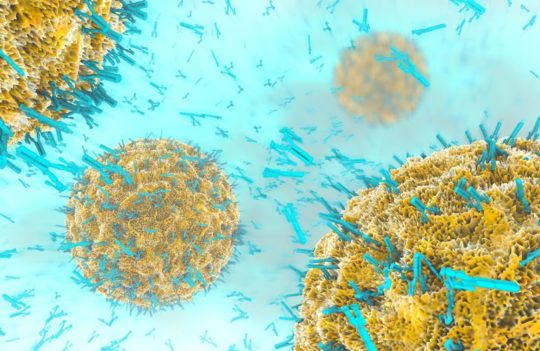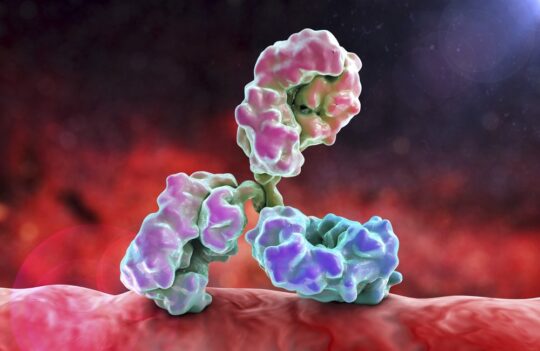 Antibody production
Antibody production
How advanced monoclonal antibody generation methods are improving conventional envenoming treatments
Snakebite envenoming has been on WHO’s priority list of neglected tropical diseases since 2017. Due to the complexity and variability of the toxins transmitted by the bite of venomous snakes, traditional treatment methods rely on snake antivenoms. The production of these antivenoms has remained virtually unchanged since the 1800s and it consists of the hyperimmunization of large animals (i.e. horses) with snake venom and harvesting their antibody-enriched plasma for treatment. The process is time-consuming, expensive, and often results in harmful side effects. In this context, monoclonal antibody generation methods are emerging as an alternative. Specifically, antibody phage display platforms for therapeutic applications are increasingly sought-after due to being a cost-effective approach for the development of better treatments.
Envenoming is an urgent public health concern
Even today, snakebite envenoming is still considered a life-threatening disease and an important public health concern in rural areas of tropical and sub-tropical countries. In these regions, hundreds of millions of people who are exposed to snakebites daily also have limited access to adequate health care systems. As a result, the World Health Organization (WHO) estimates that many snakebites still go unreported.
As of June 2017, snakebite envenoming was added to WHO’s priority list of neglected tropical diseases (NTDs). About 5 million snakebites occur every year, resulting in 2.7 million cases of envenoming. Reports suggest that between 81,000 to 138,000 people die as a result and as many as 400,000 people have been permanently disabled or disfigured after injection or exposure to snake venom.
Limitations of conventional antivenom treatments
Conventional antivenoms are polyclonal antibody preparations harvested from hyperimmunized large domesticated animals such as horses, sheep, donkeys, or camels. Despite the established effectiveness of this treatment in quickly counteracting the life-threatening effects of snake toxins, its efficiency comes at a high cost.
Antivenom production is expensive due to the costs of housing snakes and horses for long periods. Conventional antivenoms also suffer from batch-to-batch variability, heavily impacting their treatment efficiency. Another limitation of conventional antivenom production is toxin diversity within a single venom. Around 250 snake species are listed as being of medical importance by WHO, their venom consists of a wide variety of peptides and proteins that induce strong inflammatory and neurotoxic effects.
Typically, venom from a single snake species consists of a multifunctional cocktail of phospholipases, metalloproteases, serine proteases, and three-finger peptides that act synergistically in immobilizing the organism. Moreover, many snake toxins are yet to be structurally and pharmacologically characterized.
For this reason, an animal hyperimmunized with venom from a single snake species may generate antibodies that are inefficient against the venom from other snake species. This species-specificity of antivenom treatments further increases production costs.
Beyond the production limitations, conventional antivenoms are also known to frequently cause adverse reactions in patients. These reactions can be acute (anaphylactic or pyrogenic), typically occurring within an hour after administration, or delayed (serum sickness type), manifesting between 5 to 14 days after treatment.
In extreme cases, patients may die as a result of acute anaphylactic shock. For this reason, antivenom treatments are only recommended in high-risk patients (e.g. children) or when the venom’s toxicity is significantly high.
Small improvements in conventional antivenom therapies
With the onset of recombinant technologies and advanced monoclonal antibody generation methods, antivenom therapies have been improving. For instance, serum from hyperimmunized animals is now subjected to more stringent antibody purification strategies.
Moreover, the purified serum is often digested with specific proteases to produce antigen-binding fragments (Fab and F(ab’)2). This results in reduced immunogenicity (due to the absence of the xenogeneic Fc region) and lower risk of causing adverse reactions in patients. However, due to the still high production costs, many manufacturers are currently discontinuing antivenom production. This has caused a shortage of commercial supply which, to this day, remains an unsolved crisis.
With the development of venom proteomics (venomics) methodologies in 2004 and subsequent integration of these approaches with transcriptomics and genomics studies, scientists are increasingly gaining a better knowledge of toxicity and venom-induced pathologies. This knowledge is currently fueling the design of the next generation of antivenoms.
How can advanced monoclonal antibody generation methods improve these treatments?
Advanced monoclonal antibody generation technologies were first used in 1988 to develop mAbs against toxin II found in scorpion venom. At that time, researchers immunized mice with toxin II and recovered neutralizing mAbs by generating hybridomas through the fusion of spleen cells and immortal myelomas. Since then, many murine monoclonal antibodies have been generated against a plethora of different venoms.
But murine antibodies can still cause acute allergic reactions in humans. Currently, there are two main approaches to overcome the limitation of the murine hybridoma technology for monoclonal antibody generation: xenogeneic antibody humanization or fully human antibody generation (i.e. transgenic mic or antibody display technologies using human libraries). The first antivenom human monoclonal antibodies reported in the literature were produced in transgenic mice using the hybridoma technology. But these antibodies, designed to target metalloproteinase HR1a from a viper originally from Japan, only partially inhibited the toxic effects.
In recent years, antivenom antibody discovery has been dominated by phage display technology on human or camelid antibody libraries. The first report of a successful antivenom antibody obtained through this platform was publish in the late 1990s.
Multiple studies since then suggested that phage display from naïve libraries was adapted for the discovery of urgently needed monoclonal antivenoms. The reasons for the success of this platform may be explained by the possibility to use a single library to quickly screen for multiple toxins, moreover, since the antibodies are generated in vitro, toxicity ceases to be a concern.
Antibodies developed in these platforms (generally in scFv and IgG format) have shown promising results in preclinical tests either as monotherapies or as oligoclonal antibody cocktails. Moreover, some authors have also used phage display to engineer monoclonal antibodies to cross-react with more than one toxin. Unlike other applications, such as antibodies used for medical diagnostics, cross-reactivity is a desirable property for antivenom development due to the complex mixture of different toxins in a single venom.
Moreover, cross-reactive antibodies have a lower production cost in comparison to oligoclonal antibody mixtures and are also more effective against venoms because they target multiple toxins instead of targeting only one.
This has been demonstrated by multiple studies, the most noticeable of these was recently published by researchers from the National Autonomous University of Mexico. These researchers applied semi-rational design to build a mutated antibody library using a human scFv targeting a toxin (Cn2) from scorpion venom. From this library, they generated an scFv able to neutralize 13 different neurotoxins from 9 different scorpion species.
Concluding remarks
Monoclonal antibody generation techniques, such as antibody phage display, have only recently been applied to antivenom development. Experts believe that due to the decreasing costs and higher efficiency of current technologies, monoclonal or oligoclonal antibodies may soon replace conventional polyclonal therapies in the treatment of envenoming.
Advanced technologies may help researchers overcome current constraints in antivenom treatment and further alleviate the burden of this life-threatening disease in developing countries.
In the long-term, shifting from animal-dependent polyclonal antibody production to a standardized monoclonal production will reduce production costs (i.e. no need to house large domestic animals for long periods), reduce the risks of acute or delayed adverse reactions, and increase the treatment’s efficiency when dealing with complex multi-toxin venoms.
- De Silva, H. A. et al. Adverse reactions to snake antivenom, and their prevention and treatment. Br J Clin Pharmacol. 2016; 81(3): 446–452. doi: 10.1111/bcp.12739
- Ferraz, C. R. et al. Multifunctional Toxins in Snake Venoms and Therapeutic Implications: From Pain to Hemorrhage and Necrosis. Front Ecol Evol. 2019; 7:218. doi: 10.3389/fevo.2019.00218
- Laustsen, A.H. et al. Pros and cons of different therapeutic antibody formats for recombinant antivenom development. Toxicon. 2018; 146:151–175. doi: 10.1016/j.toxicon.2018.03.004
- Pucca, M. B. et al. History of Envenoming Therapy and Current Perspectives. Front Immunol. 2019; 10:1598. doi: 10.3389/fimmu.2019.01598
- Riaño-Umbarila, L. et al. Generation of a Broadly Cross-Neutralizing Antibody Fragment Against Several Mexican Scorpion Venoms. Toxins (Basel). 2019; 11(1):32. doi: 10.3390/toxins11010032
- World Health Organization (WHO). Snakebite envenoming. Retrieved from https://www.who.int/health-topics/snakebite




